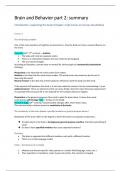Summary
Notes/lecture summary for Brain and Behavior pt.2
- Course
- Institution
The summary for Brain and Behavior pt.2, of all lectures. Includes pictures and clear explanations. Terms are in bold and people are marked in blue. The lectures are divided into headings for an overview. Exam passed with a 6.7.
[Show more]



